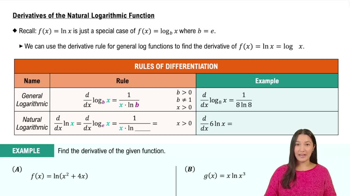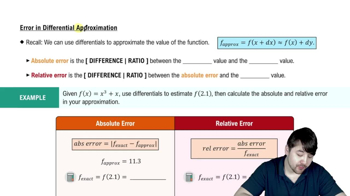Table of contents
- 0. Functions7h 52m
- Introduction to Functions16m
- Piecewise Functions10m
- Properties of Functions9m
- Common Functions1h 8m
- Transformations5m
- Combining Functions27m
- Exponent rules32m
- Exponential Functions28m
- Logarithmic Functions24m
- Properties of Logarithms34m
- Exponential & Logarithmic Equations35m
- Introduction to Trigonometric Functions38m
- Graphs of Trigonometric Functions44m
- Trigonometric Identities47m
- Inverse Trigonometric Functions48m
- 1. Limits and Continuity2h 2m
- 2. Intro to Derivatives1h 33m
- 3. Techniques of Differentiation3h 18m
- 4. Applications of Derivatives2h 38m
- 5. Graphical Applications of Derivatives6h 2m
- 6. Derivatives of Inverse, Exponential, & Logarithmic Functions2h 37m
- 7. Antiderivatives & Indefinite Integrals1h 26m
- 8. Definite Integrals4h 44m
- 9. Graphical Applications of Integrals2h 27m
- 10. Physics Applications of Integrals 2h 22m
4. Applications of Derivatives
Differentials
Problem 4.R.84
Textbook Question
82–89. Comparing growth rates Determine which of the two functions grows faster, or state that they have comparable growth rates.
ln x and log₁₀ x
 Verified step by step guidance
Verified step by step guidance1
Step 1: Understand the problem by identifying the two functions involved: ln(x) and log₁₀(x). These are logarithmic functions with different bases. ln(x) is the natural logarithm with base e, and log₁₀(x) is the common logarithm with base 10.
Step 2: Recall the change of base formula for logarithms, which allows us to express log₁₀(x) in terms of ln(x). The formula is: log₁₀(x) = ln(x) / ln(10). This will help us compare the growth rates of the two functions.
Step 3: Analyze the growth rates by considering the derivative of each function. The derivative of ln(x) with respect to x is 1/x, and the derivative of log₁₀(x) with respect to x is 1/(x ln(10)).
Step 4: Compare the derivatives: Since 1/x is greater than 1/(x ln(10)) for all x > 0, ln(x) grows faster than log₁₀(x) as x increases.
Step 5: Conclude that ln(x) grows faster than log₁₀(x) because the derivative of ln(x) is larger than the derivative of log₁₀(x) for all x > 0, indicating a faster rate of increase.
 Verified video answer for a similar problem:
Verified video answer for a similar problem:This video solution was recommended by our tutors as helpful for the problem above
Video duration:
4mPlay a video:
Was this helpful?
Key Concepts
Here are the essential concepts you must grasp in order to answer the question correctly.
Growth Rates of Functions
The growth rate of a function describes how quickly its value increases as the input approaches infinity. In calculus, we often compare functions by analyzing their limits or using L'Hôpital's rule to determine which function grows faster. Understanding growth rates is essential for comparing functions like ln(x) and log₁₀(x).
Recommended video:

Intro To Related Rates
Natural Logarithm vs. Common Logarithm
The natural logarithm, denoted as ln(x), is the logarithm to the base e (approximately 2.718), while log₁₀(x) is the logarithm to the base 10. These two logarithmic functions have different properties and growth rates, which can be analyzed using their derivatives or limits. Recognizing the differences between these logarithmic functions is crucial for the comparison.
Recommended video:

Derivative of the Natural Logarithmic Function
Limits and L'Hôpital's Rule
L'Hôpital's Rule is a method used to evaluate limits of indeterminate forms, such as 0/0 or ∞/∞. By taking the derivative of the numerator and denominator, we can simplify the limit and determine the growth rates of functions. This technique is particularly useful when comparing ln(x) and log₁₀(x) as x approaches infinity.
Recommended video:

One-Sided Limits







